Page 37:
- Scuba in the grotto of Iles des Pins in New Caledonia
- I scuba dived under the S/S France!.
- Shark diving in California. |
Scuba in the grotto of Iles des Pins in New Caledonia. |
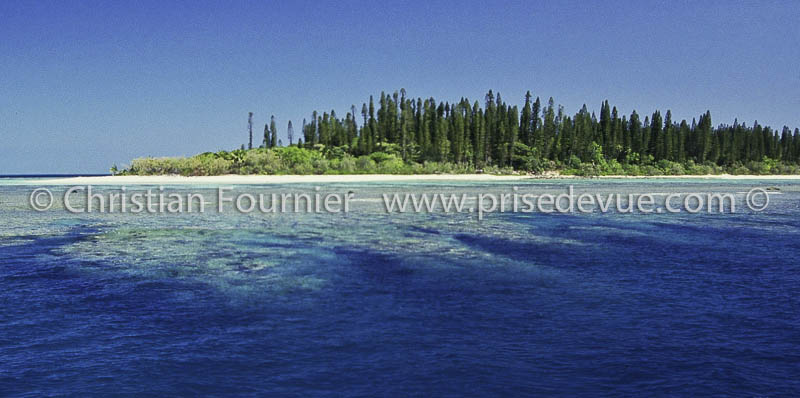
|
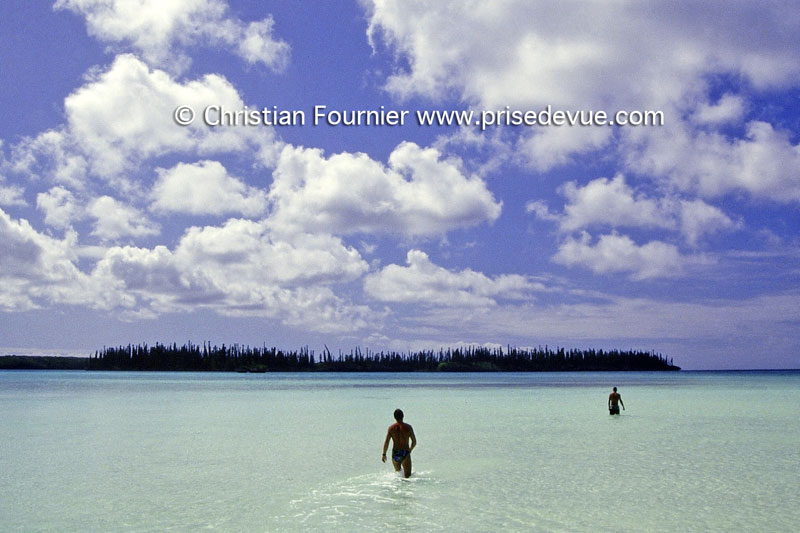 |
 |
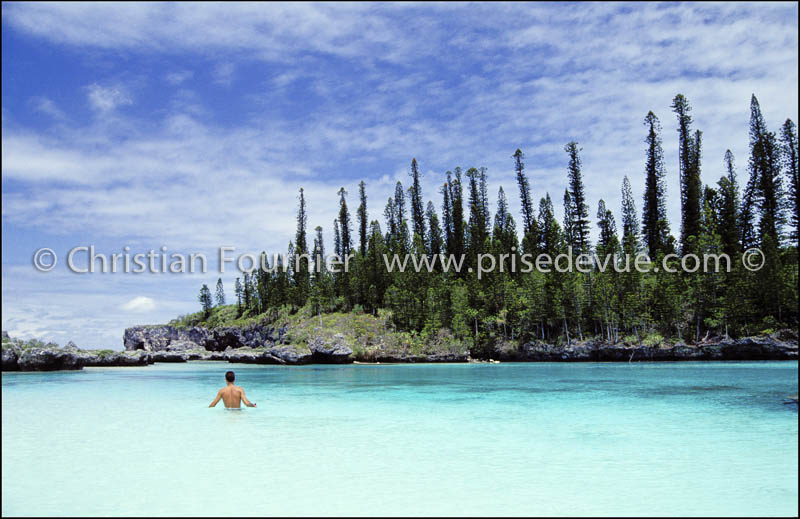 |
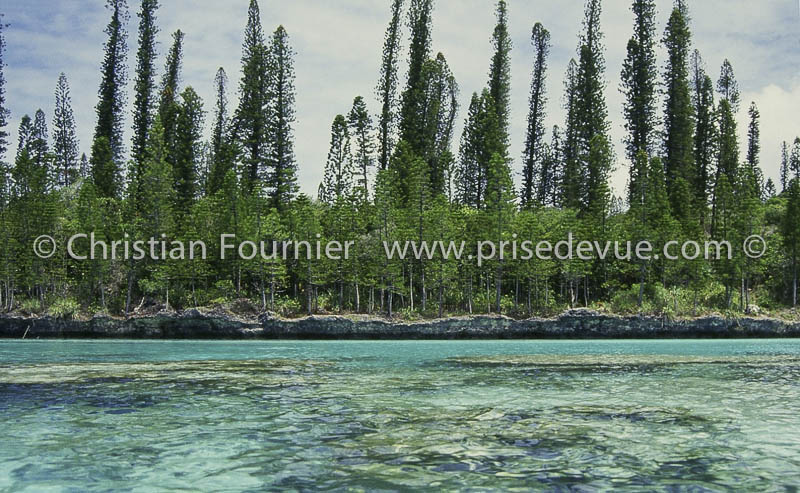 |
 |
 |
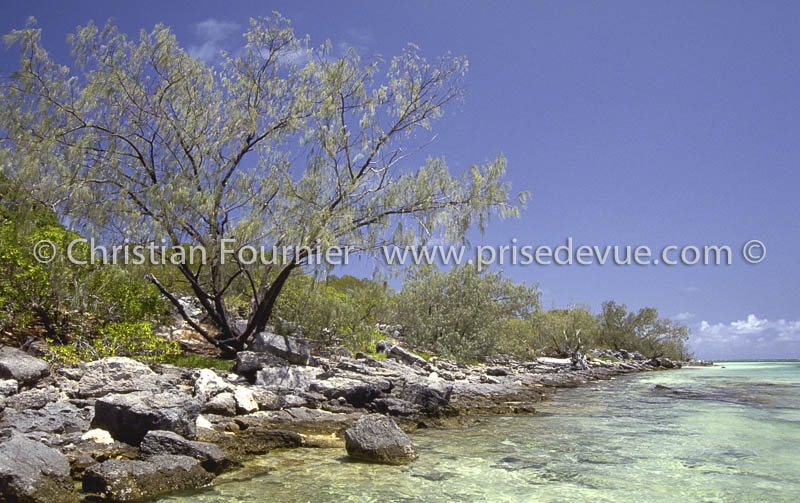 |
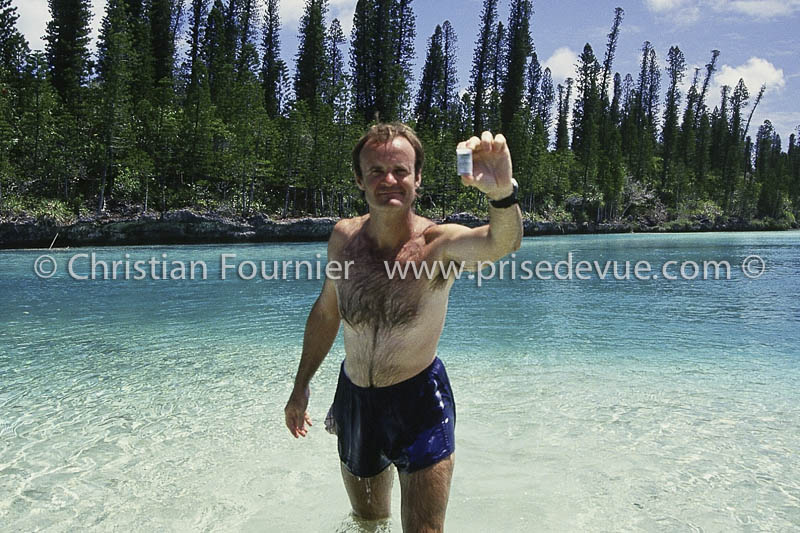 |
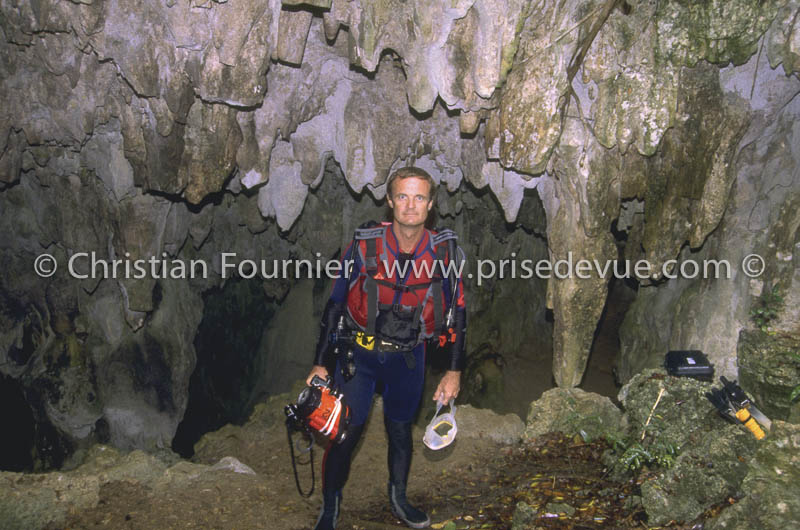 |
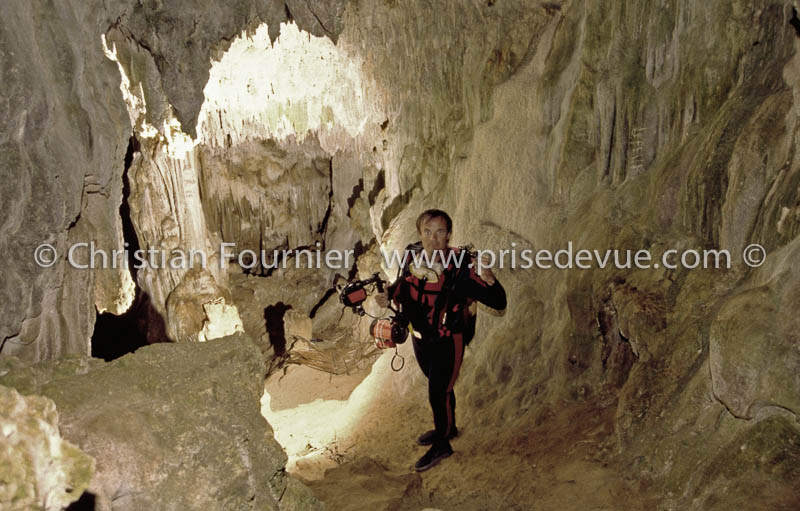 |
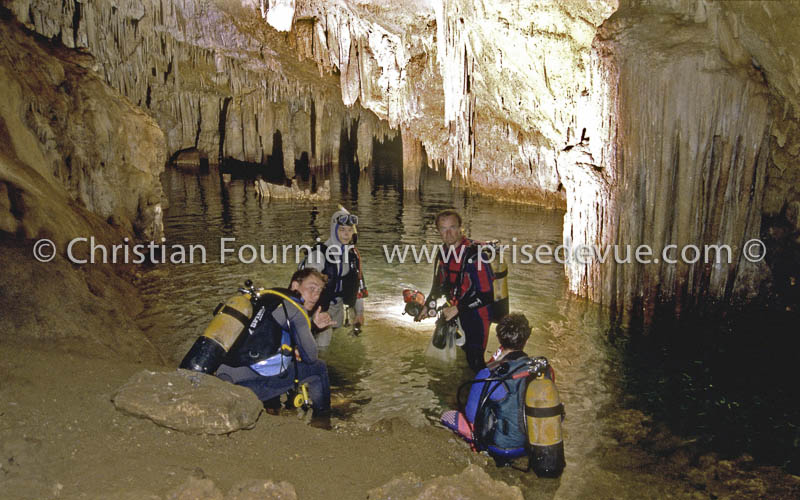 |
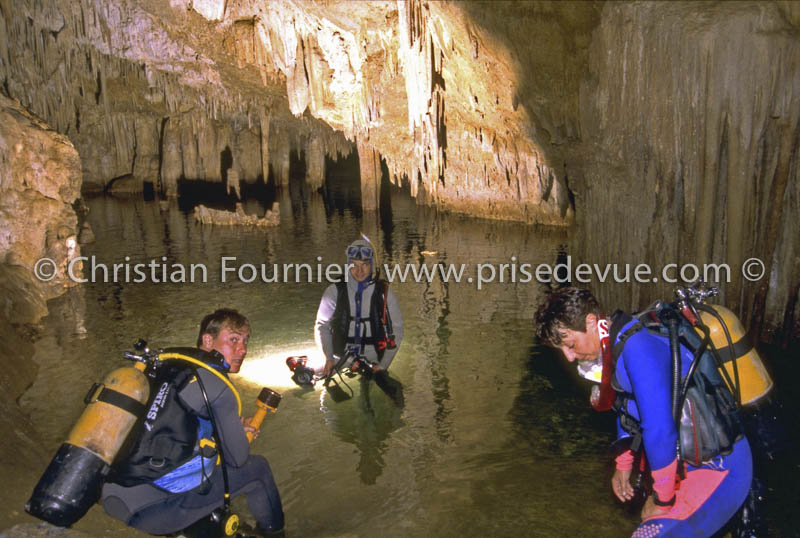 |
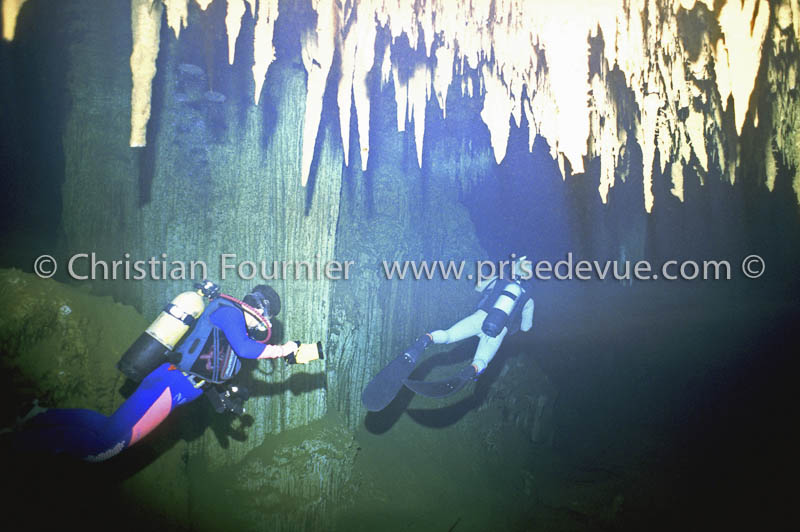 |
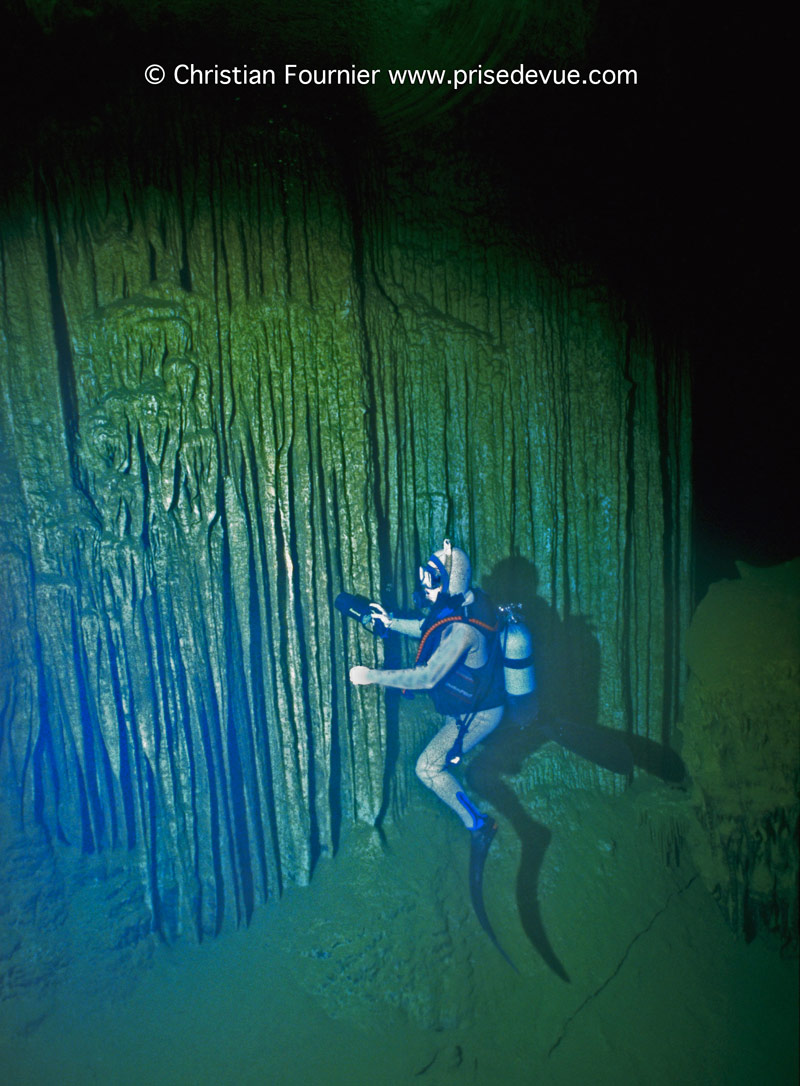
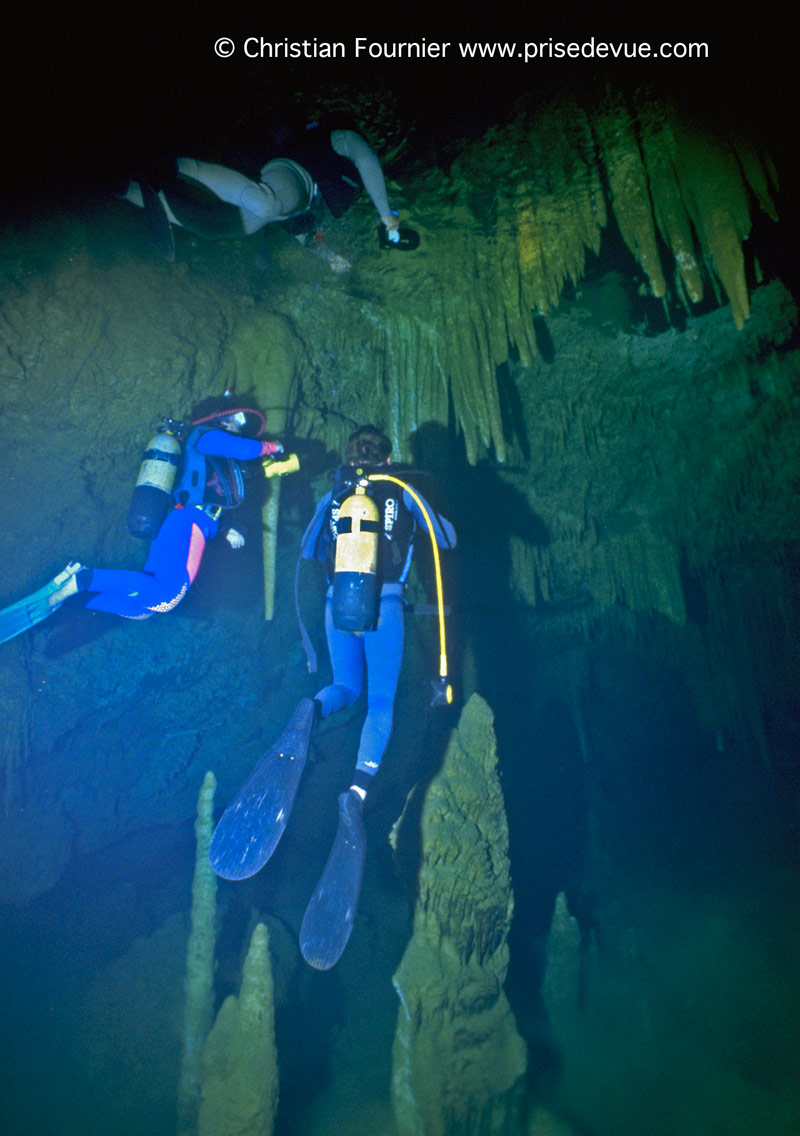
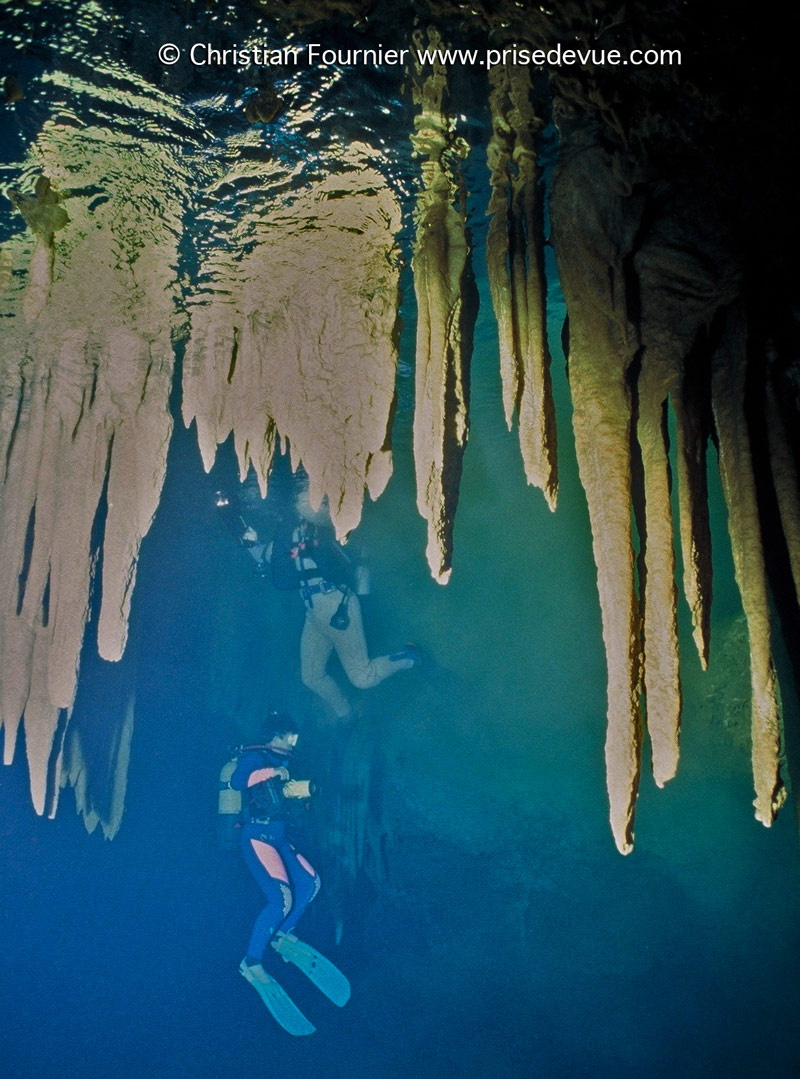

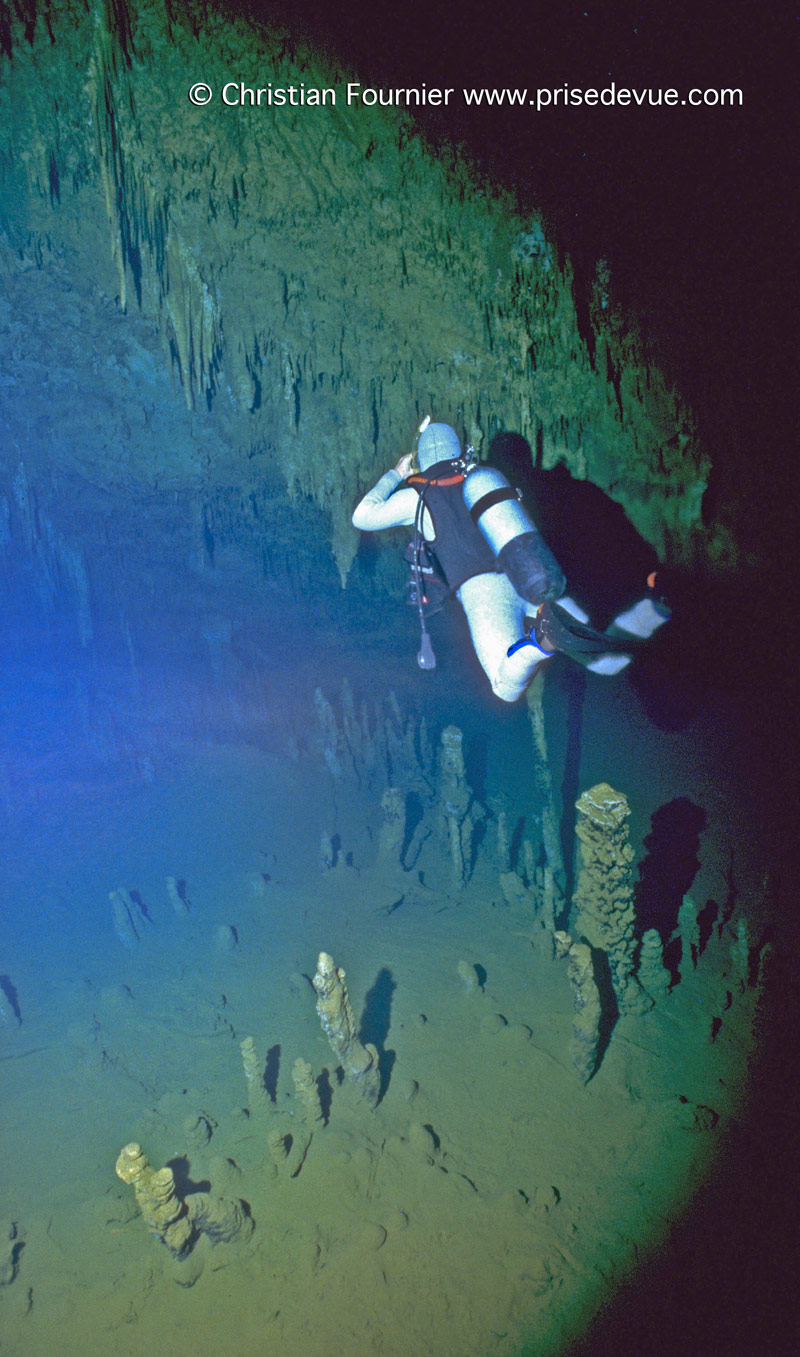
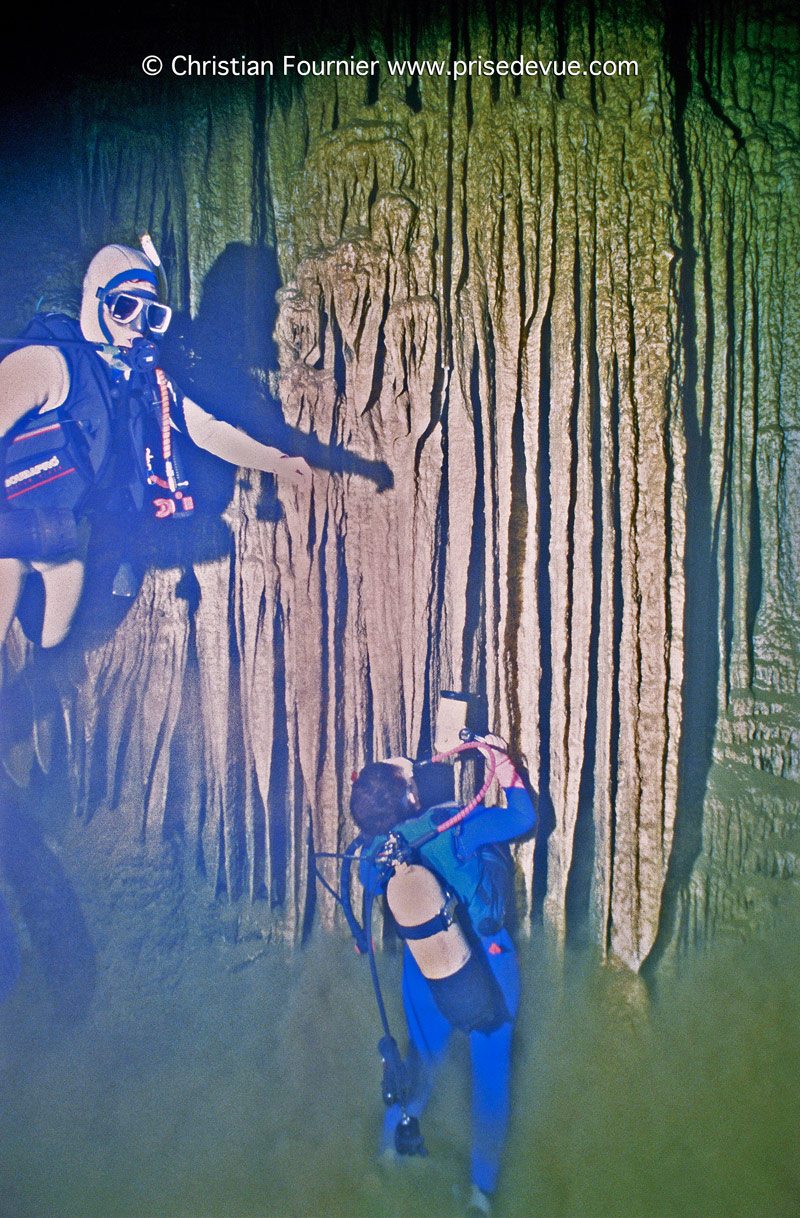 |

TEXT AND PHOTOS: CHRISTIAN FOURNIER |
New Caledonia is located 1,750 km east of Australia in the South Pacific Ocean.
It is an overseas territory of France. The Isle of Pines, which is the Southern most Melanesian Island is situated 70km southeast of the main island of New Caledonia.
Captain Cook, when first sighting the island in 1774, thought the colonial pines, from which Isle of Pines got its name, to be stalagmites.
The island is 17km long by 14 km wide and rises 256m above sea level. It is in fact a raised atoll without rivers. Its geology is rather unique : calcite caves got flooded, under or above sea level.
There are approximately 1400 inhabitants and these are exclusively Melanesian.
Mainly because of its remoteness, Isle of Pines remains as Cook discovered it : unspoiled, with long white sandy beaches and virgin forests.
In the vicinity of the Bay of Ouameo, in the middle of the tropical vegetation, there is an underground cave, known as " the grotto of the third". The name comes from the third commune of French convicts that used it. This grotto leads to a fresh water cave, full of stalactites, stalagmites and columns. The excellent dive shop, the Nauticlub, at the "gite Kodjeue", can help you visit these caves. A short truck ride, a short walk trough the jungle with your scuba gear on, a short slippery climb down through the caves and you get to the water. The scenery is breathtaking : you can still see a hole in the ceiling where the trees are, amazing rock formations all around you (stalactites, stalagmites and columns), and crystal clear water at your feet.
Final adjustments to the scuba gear, double check on the camera equipment, triple check on the underwater lights, and off we go. It is cold and dark and awesome. The water is extremely clear, but watch out for those fins kicking the bottom, creating clouds of sand that will take days to dissipate. Philippe Scheidt knows the caves and leads the way. I feel very privileged to be able to admire those wonderful sights. How many people can understand that ?
We do not see any fish or any kind of marine life, except at the very bottom of a very narrow corridor, a crayfish, that quickly hides away as we approach. There are many tunnels and small rooms to explore. I am glad that Philippe really knows his way ; the thought of getting lost here does not appeal to me. There are pockets of air in some areas, large openings in others : we surface there to look at the stalactites hanging above our heads, like swords. When submerged and above your head, these swords remind you to keep you buoyancy very well adjusted : you do not want to bump your head on those and you do not want to kick up the bottom sand either. Thank goodness for automatic inflation.
One stalagmite looks like a cat, with its ears pointed. In another corner, there are hanging chandeliers. Further away there is another exit (or entrance, according to which way you look at it ! ) that leads to a small pebble underground beach. The only beach in New Caledonia where you do not fear sun strokes !
There are thermoclines in this water, some very cold parts right next to warmer ones. Around a corner, everything suddenly becomes blurry. Have the cold or the darkness or the eeriness of the place made me shortsighted, all of a sudden ? Of course not, I feel completely at ease and I remember seeing this phenomena in "Xel-Ha", a lagoon in Mexico, where underground springs mix fresh water to salt water. Could there be some salt water leaking through this fresh water ? My guess is that it must be that or another chemical dissolving there. I did ask a geologist in Nouméa : he was positive : this calcite does not dissolve in the water. It makes sense, otherwise the grotto would have been long gone. I took pictures of the blurry areas. They came out blurry ! And yes, I did focus properly.
The caves are never very deep. Our maximum depth for the entire dive is thirty five feet. This gives us good bottom time, even though we are using smaller tanks (10 liters) for better maneuvering through the tunnels.
Then, we got to the large room, the "cathedral", one hundred and fifty feet long and the same in height. What a sight. The large wall looks like a giant organ. I timed it well : I still have some frames left. I make full use of the target light which is built in my strobe. In the total darkness, with a wall in front, as I am using a very wide angle lens, wider than the strobe’s, I could spoil many frames by not aiming dead on. This does not matter on regular night dives, because the corners are supposed to be dark anyway. But the fantastic thing is the clarity of this water : no fear here of back scatter, due to particle illumination, providing we do not disturb the sand. From the back wall, one hundred and fifty feet away, I could very clearly see my buddies shining their lights at the organ.
When the last breath of air in our tanks has been used up, we turn back, swimming through the now troubled water that we disturbed on our way in. Back to the underground beach, the dry caves, the opening through the jungle and the beaten up truck.
Text and Photos : Christian Fournier |

Under the cruiseship S/S France, the US Virgin Islands.
|
The propeller shafts weren’t turning properly. I
was employed to photograph the chipping in order to evaluate
the mess.
The majestic liner S/S Norway, once the S/S France, is in the
mooring off the coast of Saint Thomas.
Besides the impressive bulk of the ship in front of us, there
is nothing else but a deep blue. I pass my gloved hand over the
rim of the propellers and, when I feel a catch, I photograph it
properly, in macro mode, including a tiny ruler in the photo,
and note its position on my slate. There were about twenty
chips on the eight blades.
The current was pushing us forcefully and we had to do
everything with one hand held onto a blade. There wasn’t a
single fish and nothing but blue around the ship.
It leaves a lasting impression. Boundless blue and an mammoth
metal machine. I felt very small and fragile.
And privileged as well, to be able to dive under the most
beautiful liner in the world. My report was published in every
francophone diving magazine. Nostalgia for the SS France?
For extraordinary diving? For my magnificent
photos?
|
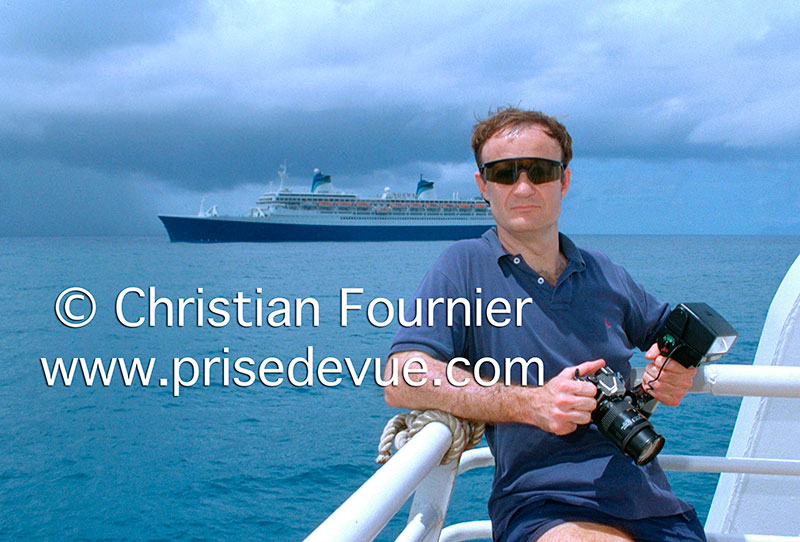
S/S Norway. View other reportages about S/S Norway, ex Le Paquebot France on pages 19 and 33
|
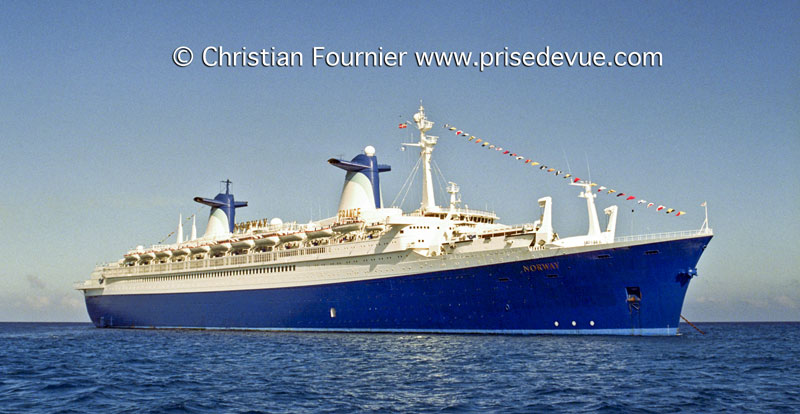 |
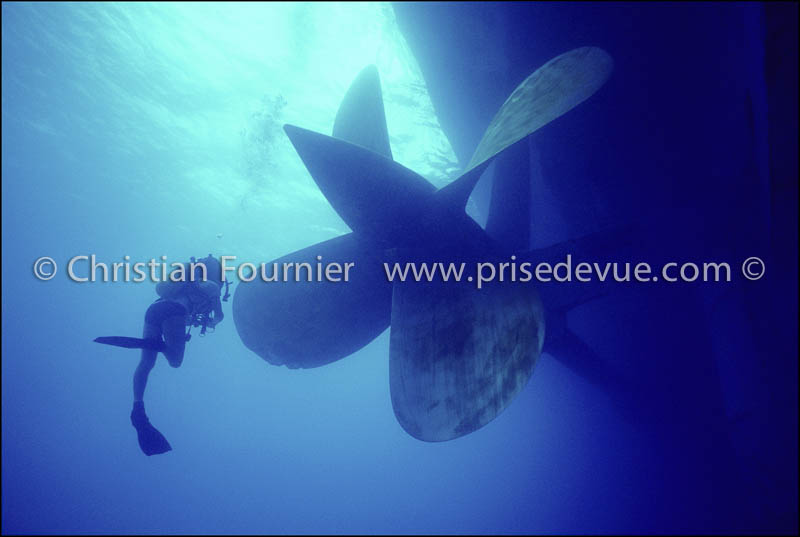
With Greg Hellman.
|
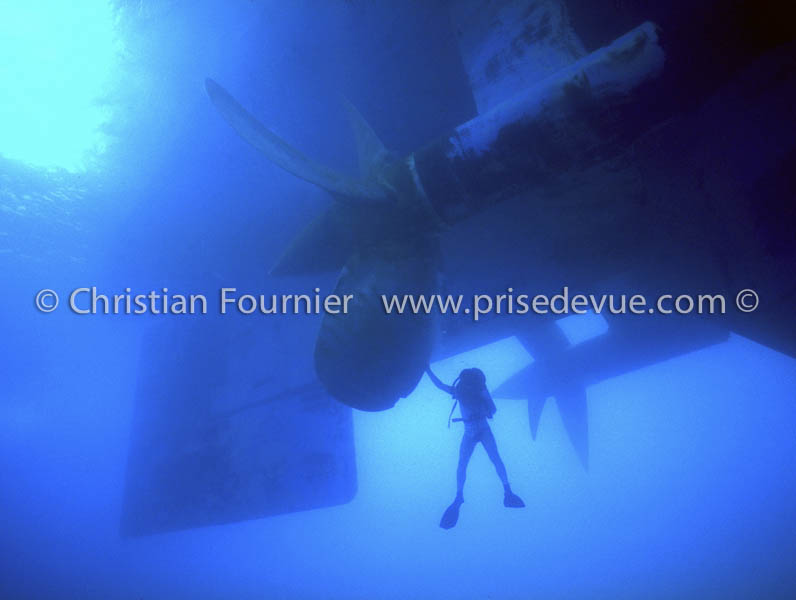 |
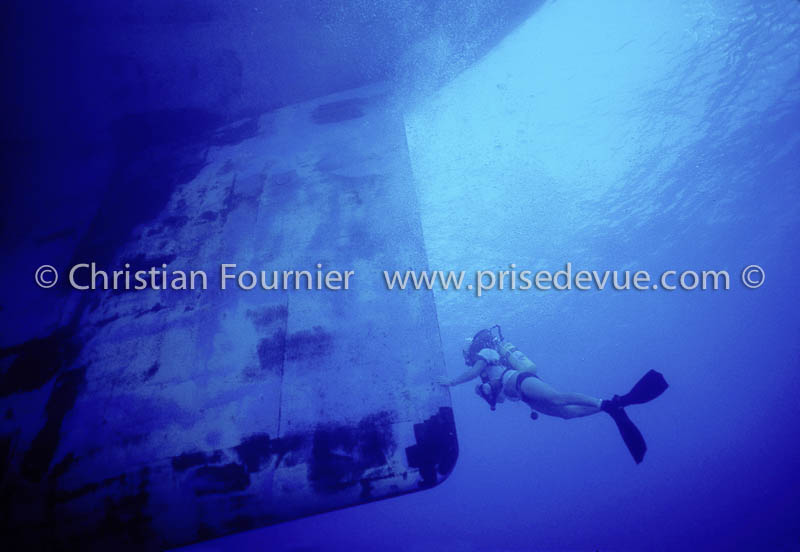 |
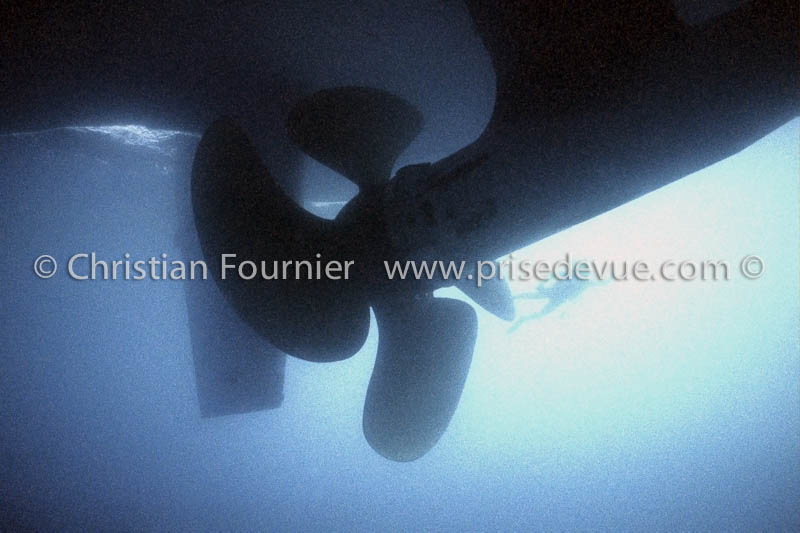 |
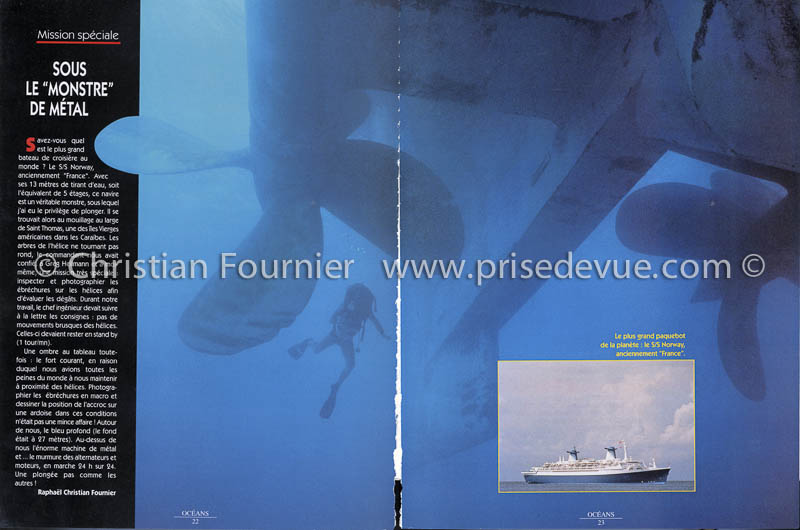 |
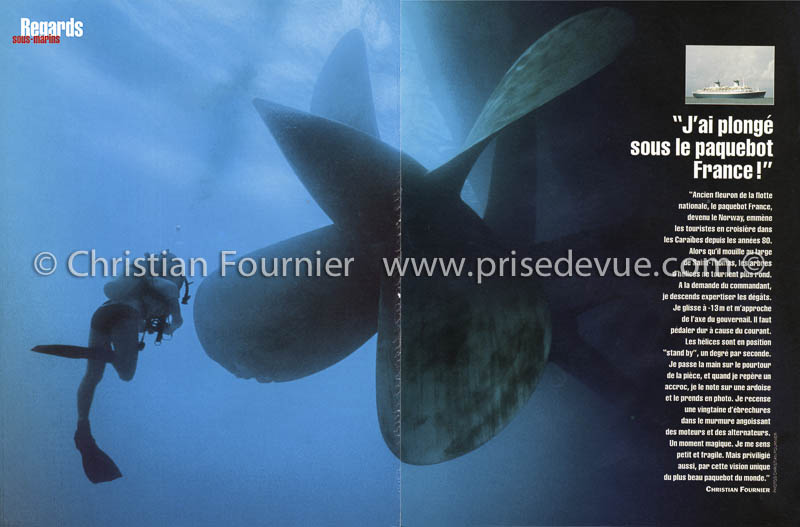 |
 |
 |
Blue sharks of California.
|
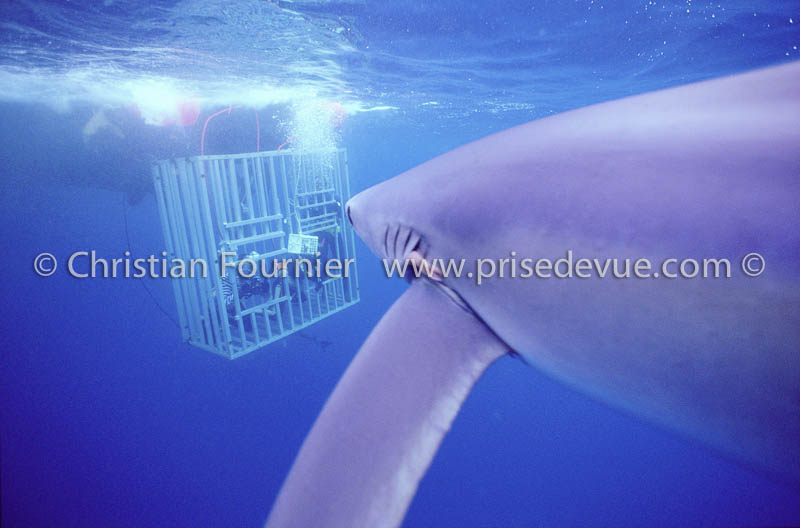 |
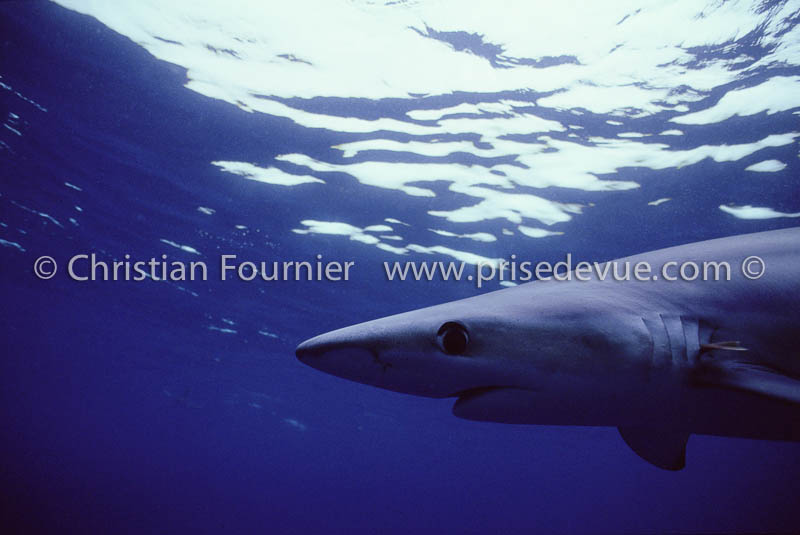 |
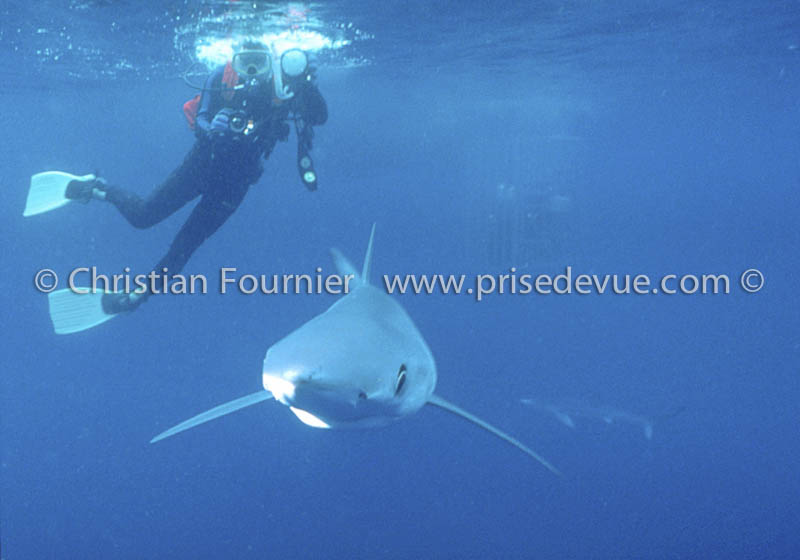 |
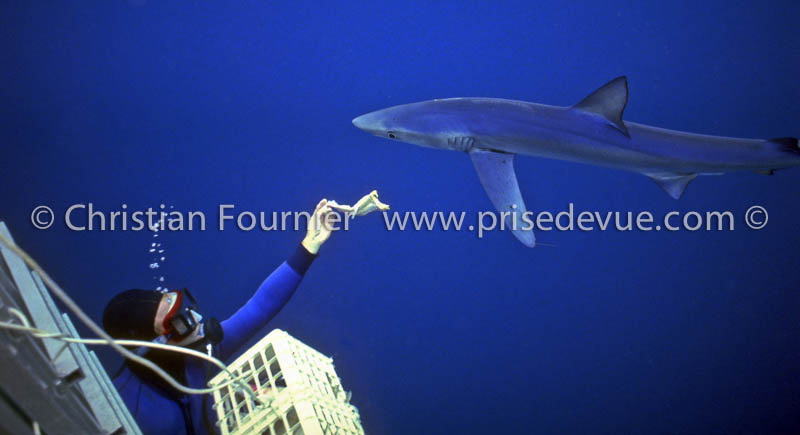 |
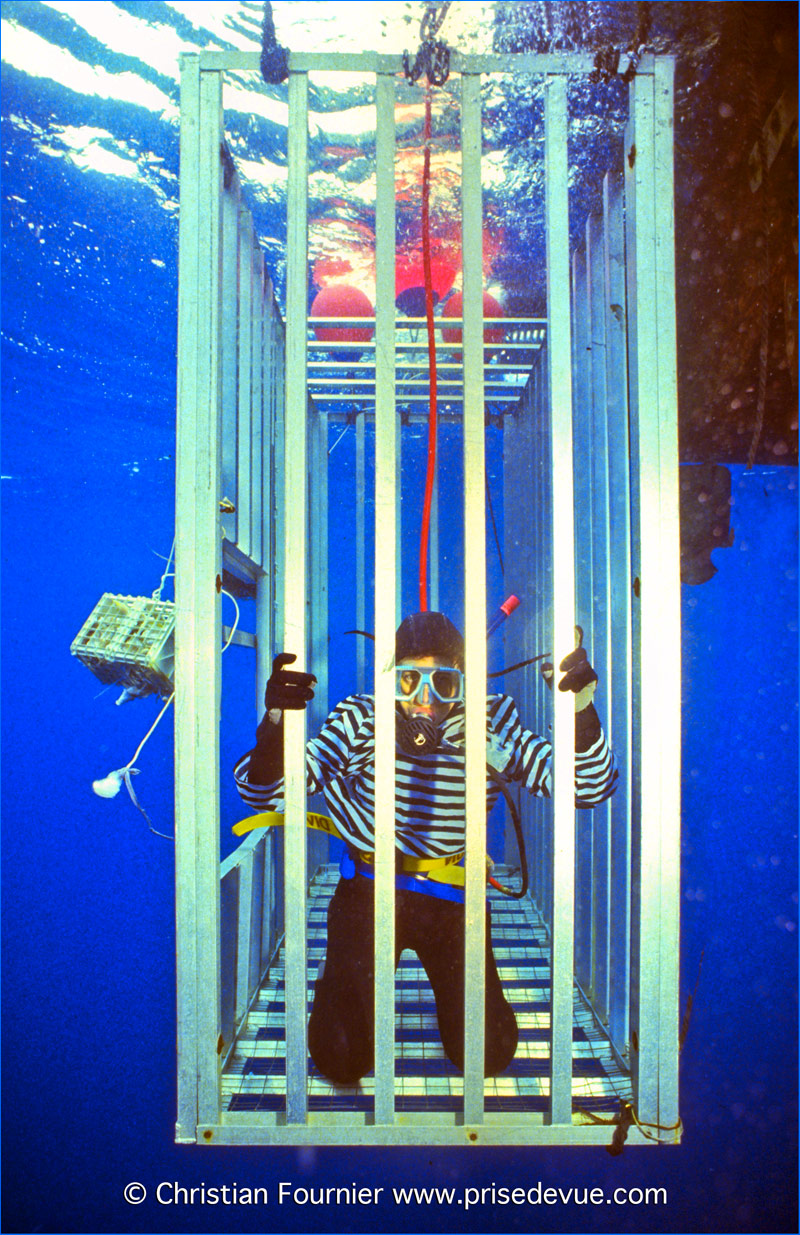 |
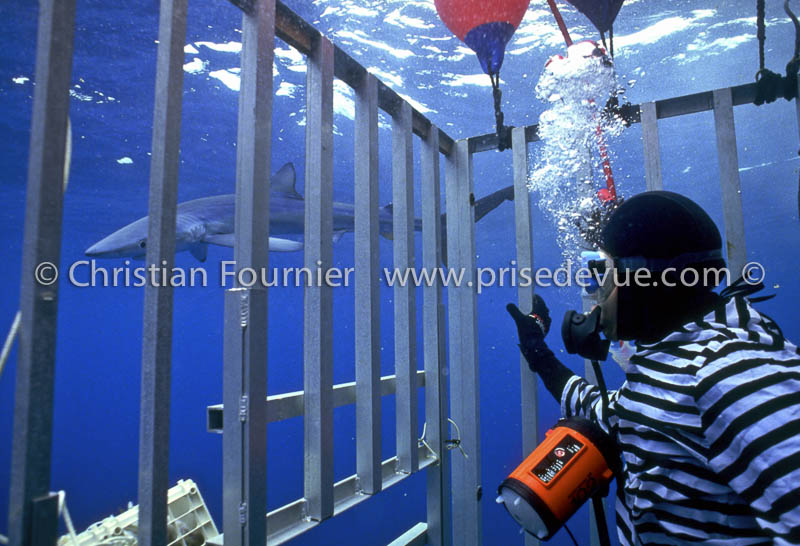 |
 |
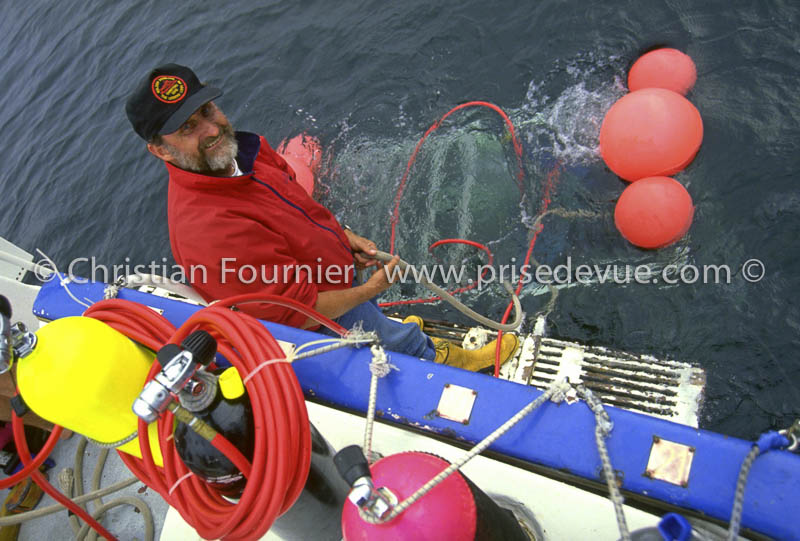 |
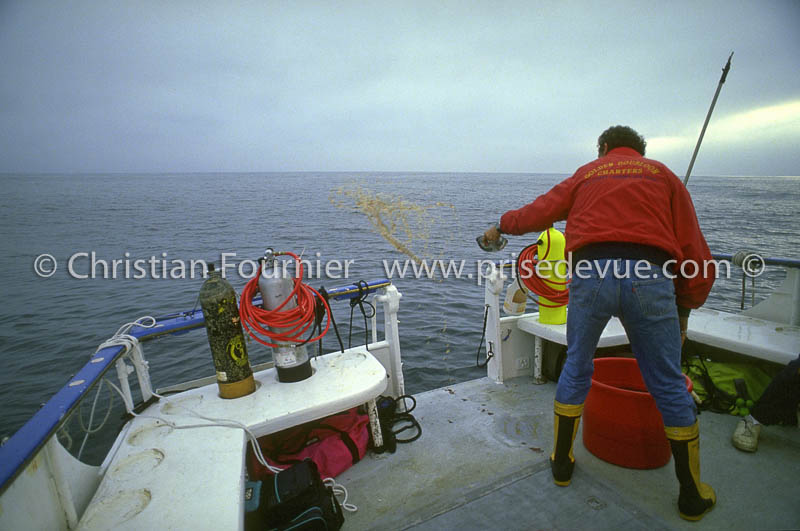 |
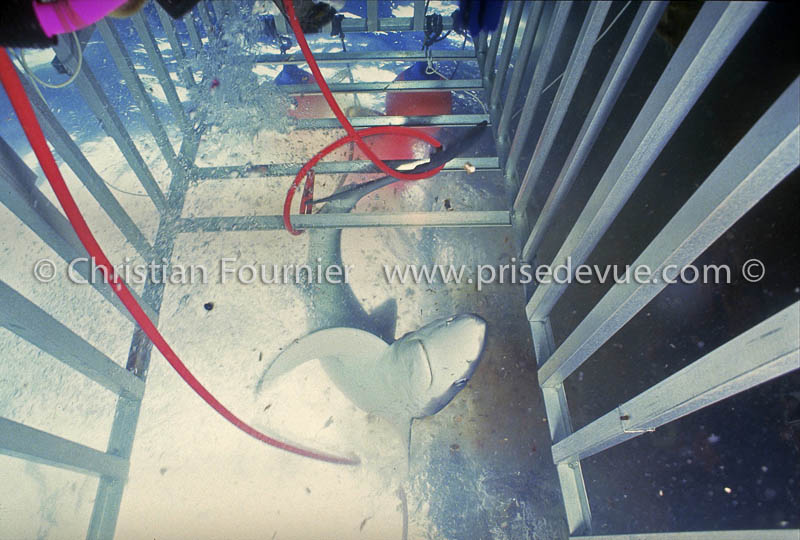 |
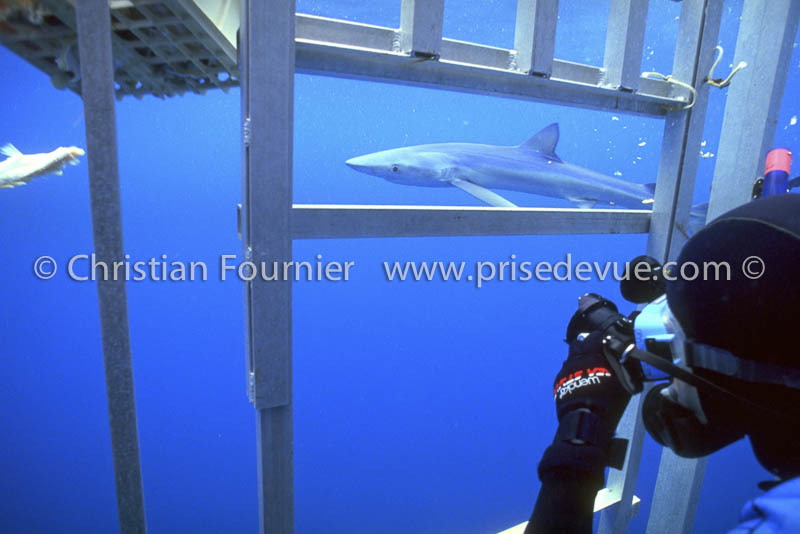 |
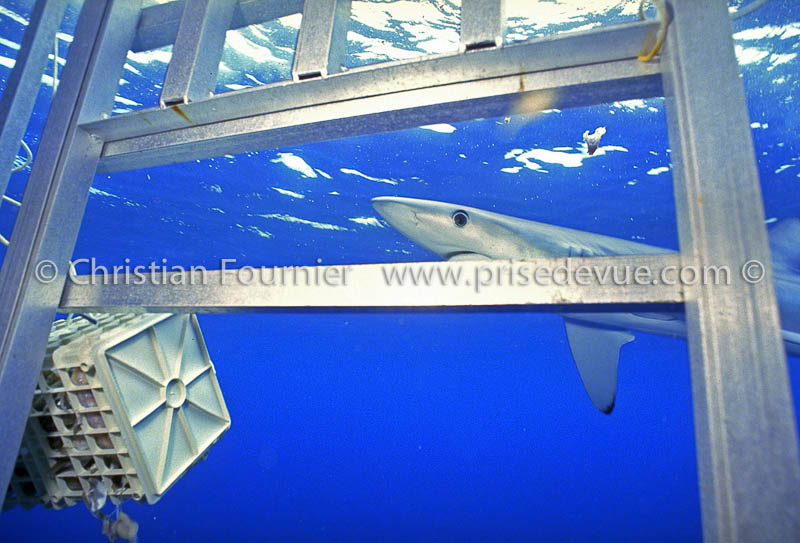 |
 |
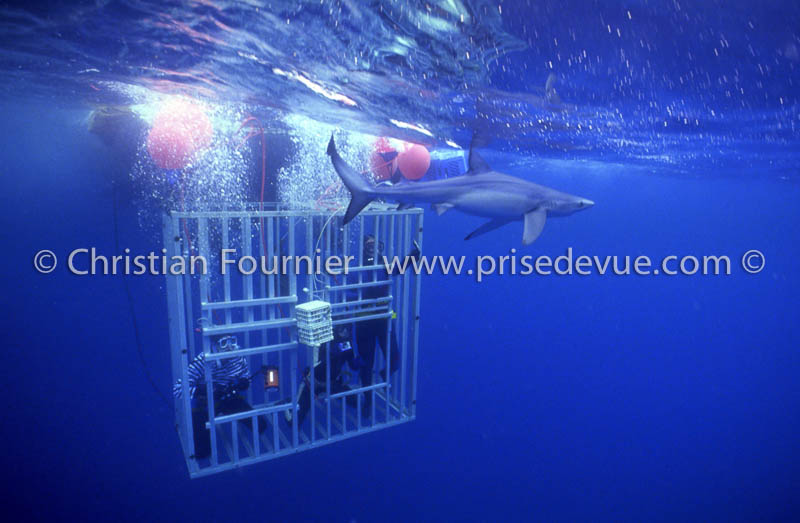 |
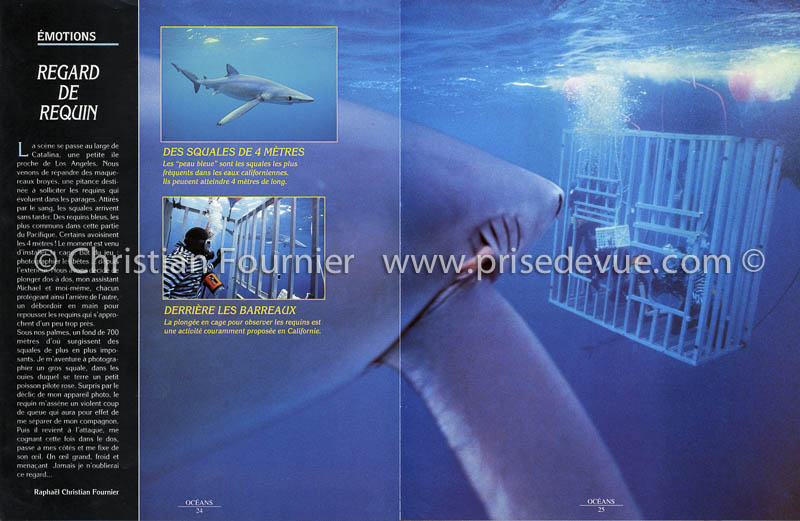 |
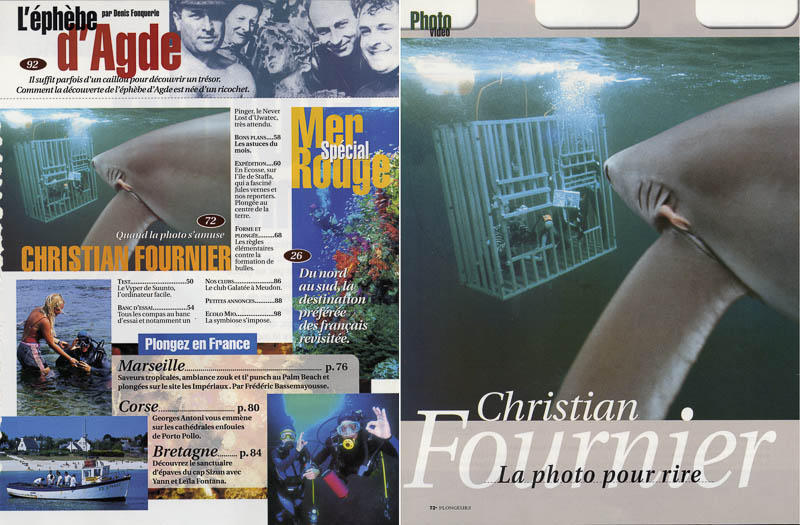 |
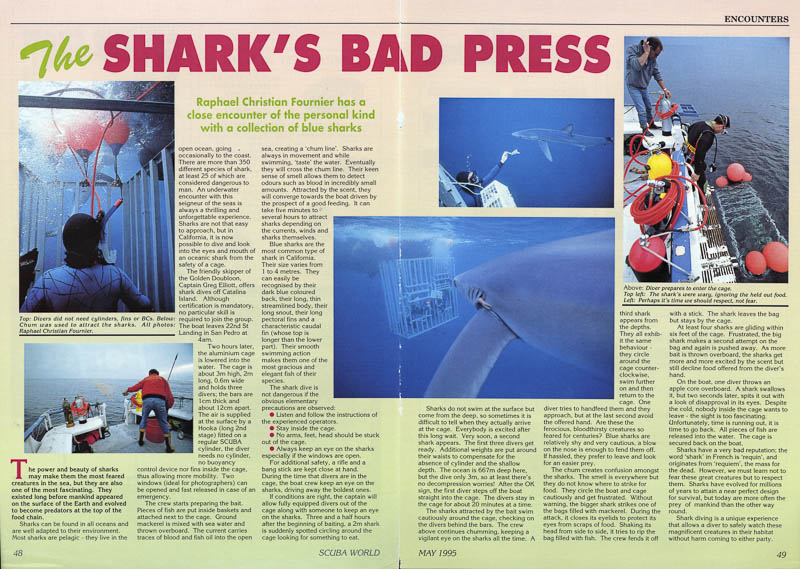 |
The power and beauty of the sharks make them the most feared creature in the sea but also one of the most fascinating.
|
They existed long before mankind appeared on the surface of Earth and evolved to become the top predators of the food chain.
Sharks can be found in all oceans and are well adapted to their environment. Most of the sharks species are pelagic creatures : they live in the open ocean, going occasionally to the coast.
There are more than 350 different species of sharks : some 25 at least are considered dangerous to men.
An underwater encounter with this seigneur of the seas is always a thrilling and unforgettable experience. But sharks are not so easy to approach. It is now possible, in California, to dive and look into the eyes and mouth of an oceanic shark, from the safety of a cage. The friendly skipper of the Golden Doubloon, Captain Greg Elliott, offers shark dives off Catalina Island. His operation started about six months ago and has always been successful. These dives are limited to a maximum of 12 divers. Non divers are also encouraged to join the trip since there is as much to see above the water than underneath. Although certification is mandatory, no particular skill is required. The boat leaves 22nd St. Landing in San Pedro at 4 : 00 AM. Two hours later, the aluminum cage is lowered into the water.
The cage is about 9 feet high, 6 feet long and 2 feet wide and holds three divers ; the bars are one inch thick and about six inches apart. The air is supplied at the surface by a Hooka (long 2nd stage) fitted on a regular scuba tank, the diver needs no tank, no buoyancy control device and no fins inside the cage, thus allowing more mobility. Two windows (ideal for photographers) can be opened and fast released in case of an emergency : the opening is after all big enough to let a shark get inside the cage !
The crew starts preparing the bait. Pieces of fish are put inside baskets and attached next to the cage. Ground mackerel is mixed with sea water and thrown overboard. The current carries traces of blood and fish oil into the open sea, creating a chum line. Sharks are always in movement and while swimming, "taste" the water. Eventually they will cross the chum line. Their keen sense of smell allows them to detect odors such as blood in incredibly small amounts.
Attracted by the scent, they will converge towards the boat driven by the prospect of a good feeding. It can take five minutes to several hours to attract sharks depending on the currents, winds and sharks themselves. Very soon a school of mackerels attracted by the scent, swim around the boat. Captain Greg gives an informative talk and a briefing to the divers. Blue sharks are the most common sharks in California. Their size vary from 3 feet to 12 feet. They can be easily recognized by their dark blue colored back, their long streamline thin body, their long snout, their long pectoral fins and a characteristic caudal fin : the top is longer than the lower part.
Their smooth swim makes them one of the most gracious and elegant fish of their species. Makos, relatives of the great white, are also residents of the Californian waters. Shorter than the blue, powerful, built for speed, they are recognizable by their jaws and their erratic swim. Makos are very dangerous for men. Captain Greg reminds us that even the Cousteau divers, who are very often around sharks, get out of the water when they see a mako. But Captain Greg is prepared for such an encounter : since the mako is a hunting game, everyone will leave the boat with a delicious shark steak. Great whites do cruise in Californian waters, but are seen more rarely.
Because of their jaws and their unpredictable behavior, blue sharks are potentially dangerous but compared to the fearsome great white, they are "easy". The shark dive is not dangerous if the obvious elementary precautions are observed : - listen and follow the instructions of the experienced operators. - stay inside the cage. - no arms, feet, head sticking out of the cage. - always keep an eye on the sharks especially if the windows are open. For additional safety, a riffle and a bang stick are kept easy at hand.
During the time that divers are in the cage, the boat crew keep an eye on the sharks, driving away the boldest ones. If conditions are right, the Captain will allow fully equipped divers out of the cage along with somebody to keep an eye on the sharks. One hour and a half after the beginning of baiting, the first shark is signaled. Everybody gathers at the stern of the boat. It is a baby shark, two feet long. Unfortunately, it gets entangled in a fishing line, breaks it and runs away.
No other shark appears in the next two hours : patience is a necessary virtue when shark diving ! Suddenly a six footer is spotted, circling around the cage looking for something to eat. Sharks do not swim at the surface but come from the deep. It is sometimes difficult to realize that they are already around the cage. Everyone is excited after this long wait. Very soon, a second one arrives.
The first three divers get ready. Additional weights are put around the waist of the divers to compensate for the absence of tank and the shallow depth ; The ocean here is 2000 feet deep, but the dive only 9 feet : no decompression wo
rries here ! After the OK sign, the first diver steps off the boat straight into the cage. The divers stay in the cage for about 20 minutes at a time. Except for the boat, there is no fixed object to look at, everything is deep blue ; past 60 feet, lies the nothingness, the unknown. The sharks attracted by the baits swim cautiously around the cage checking on the strange creatures behind the bars. The crew above continues chumming, keeping at the same time a vigilant eye on the blues.
A third shark appears from the depths. They all have the same behavior : they circle around the cage counterclockwise, go further and come back to the cage. One diver tries handfeeding them : they approach but at the last second avoid the hand with the fish. Are these the ferocious, bloodthirsty creatures so feared for centuries ? The blue sharks are relatively shy and very cautious : a blow on the nose is enough to fend them off. If hassled, they prefer to leave and look for an easier prey. But sharks are not the only creatures to detect the scent : a sea lion gets interested too and surprisingly, swims fast towards a shark and bites it. Scared, the shark disappears.
The seal has been spotted from the boat and action is taken immediately : if the seal stays, the sharks will leave. The sound of the explosion of a seal bomb in the water is enough to get rid of it without bothering the sharks which continue circling around the boat. Experiments have shown that loud noises tend to attract sharks ; this is one of the reasons why sharks are present in the waters after a shipwreck.
The chum creates confusion amongst the sharks. The smell is everywhere but they do not know where to strike for food. They circle cautiously the boat and the cage and get frustrated. Without warning, the bigger one strikes one of the bag filled with mackerels. During the attack, it closes its eyelids to protect its eyes from scraps of food. Shaking its head from side to side, it tries to rip the bag filled with fish. The crew fends it off with a stick. The shark leaves the bag but stays around. At least four sharks in the six feet range are gliding in the deep blue waters around the cage. They disappear from sight from time to time but always come back to the cage irresistibly attracted.
Frustrated, the big one makes a second attempt to the bag and is pushed away a second time. Somehow, we can read anger in its eyes. As more bait is thrown overboard, the sharks get more and more excited by the scent but they still decline food offered by hand.
On the boat, one diver throws an apple core overboard. A shark swallows it, but two seconds later, spits it out with a look of disapproval in its eyes. Despite the cold, nobody inside the cage wants to leave : the sight is too fascinating. Unfortunately, time is running out : it is time to go back. All pieces of fish are released into the water. The cage is secured back on the boat. The trip is again a success !
In addition to sharks, the trip gives the chance to encounter other species too, sunfish, tuna, strange jellyfish, rays, sea lions… and with some luck, dolphins and whales. Sharks have a very bad reputation ; so bad that gray fish is used to designate shark steaks in the menu of restaurants. The name "shark" in French is "requin" and originates from "requiem", the mass for the dead !
But we must learn not to fear these great creatures but to respect them. Sharks have evolved for millions years to attain a near perfect design for survival. However today sharks are more often the prey for men than the other way around.
Shark diving is a unique experience that allows a diver to watch safely these magnificent creatures in their habitat, without harming them.
Text and Photos : Christian Fournier


|

Here are about 620 examples of my photographic event coverage since 1984, that is to say, 30 years. This is without counting those which my clients have requested that I do not show and photos that have been lost.
I know it's enormous.
No, I am not a photographic robot: my mother had me tested
This list begins with the compilations: Fashion & Models, Lingerie, Beauty, Makeup & Hair, Portraits, Events, Objects, Archi & Deco, Industry, Press, Celebrities, etc.
The sensors and web capabilities from 1995 to 2005 were horrible compared to now (2021). 40 KB max by images. My uploads at this time were therefore bad. I replace them little by little. It's long. Thank you for your indulgence.
Conclusion 1: I must not be bad, so that all these people trust me.
I have loyal customers, a sign that they are satisfied with my services. Examples: Tollens, MEDEF, Dior, GMF, Unesco, L'oréal, Anaé, Agefiph, Essilor, Genzyme, Embassy Ireland, The Advertisers Club, Garmin, VW, etc. ...
Conclusion 2: Thanks to all these varied clients (industry, wedding, corporate and personal portraits, press, events, objects, medical, culinary, diving, sports, pageants, etc. ..), I see extraordinary slices of life, confidential or public, trades and fabulous countries. I do feel very privileged. Real life, live. Thank you customers.
In rough estimation, I take 5,000 photos a week. 5,000 x 52 = 260,000 a year. For 35 years = 9,100,000 photos. Well, I would like to reach 10 million anyway!
Conclusion 3: Photography is my language
|
There is also a search command, not always up to date, but pretty comprehensive on all my reportages.

Due to manipulations between prisedevue.photos, prisedevue.photos and famousphotographer.com, some links may be broken. Sorry. I'm working on it !
|
*************************
MY BLOGS
Not many photographers have the courage to show their photos on a daily basis. I do it to show that in a wide range of photography, I always take good photos for my clients. Technical perfection and an obvious sensitivity. If you imagine the logistic necessary for these missions (estimates, preparations, equipment, transports in traffic jams, safety, etc.), you can see that I am a photographer who achieves results in all circumstances.
************************* |
 |
CONTACT
|
 |
| WWW.FAMOUSPHOTOGRAPHER.COM The archives |
*************************
Intellectual Copyright Property 2020 Christian Fournier.
All rights are reserved. All texts, photos, graphs, sound files and videos in this website are protected. Their reproduction, modification and uses on other web sites than those by Christian Fournier are strictly forbidden.
Most of the photos on my web site are for sale, except, of course, the ones for which I do not have the models or decor releases.
I am at your disposal for any query you may have.
|























































